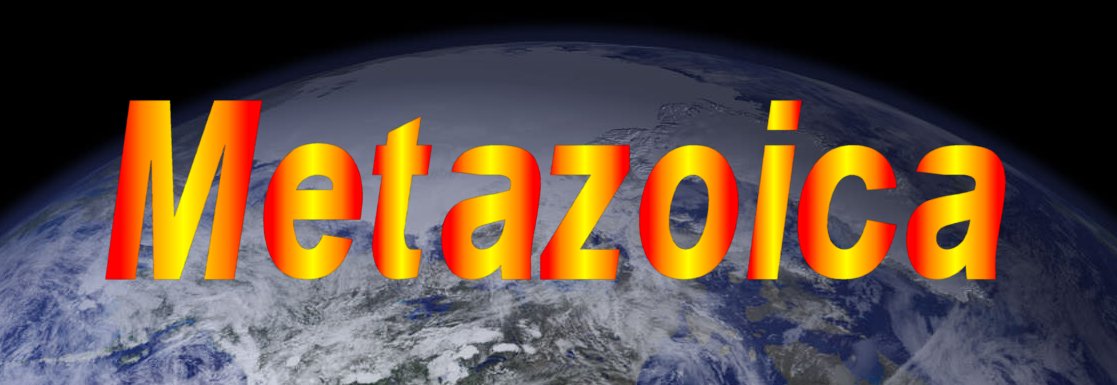Welcome to my Metazoic site! This site discusses the existence of the creatures to come along after humans will be extinct. I first became interested in a world after man when I acquired my first copy of Dougal Dixon's After Man: A Zoology of the Future in 1992. However, I unwittingly created creatures that did not exist from the time I was about 8 years old. But it was after I obtained a copy of that book (now a collector's item) that I decided to take these same creatures I created as a child and make them more realistic in an evolutionary sense. Though it may be hard for a lot of us to grasp, humans will soon become extinct. One of the biggest factors of how this will happen is the current overpopulation rate. Which is why I don't contribute to the population. I created this world with little more than mammals fulfilling all ecological niches with the help of some friends. I even gave the era of the age after man a name, I called it the Metazoic, derived from the words for "After-era" (Meta, meaning after, and zoic meaning era). We are now in the Cenozoic era. To view all the animals I have created since I began this project, you can go to the "Meet the Mammals" section of this site. To discuss your own ideas about what you think will happen in the future world, and share your ideas with others, please feel free to leave a comment.
One more thing, some of you may find this site quite offensive, and you have a right to your own opinion. But please respect my right to have an opinion too. I'm not saying there is no GOD, I believe it was HIM who got the ball rolling. But I believe after that, evolution took over. There is so much more evidence of evolution than there is of creation. Even that going on right under our noses. Other than that, enjoy yourself and visit our many links.
Tuesday, January 13, 2009
Family of the Week: the Deer
Any way you look at it, deer are rather large animals, though there are some small, shy animals even during the Metazoic. The largest deer of this time period is Megaladama. This deer stands 11 feet tall, with antlers that spread over 7 feet wide. In today's World, the moose is the largest deer, but it only stands about half as tall as Megaladama. This deer is a plains-dweller that lives alone or in small family groups. The males aggressively defend the females and young. The deer with the largest set of antlers is actually Spoudaioceros, which are as long in proportion to it's body size as the antlers of the prehistoric Irish elk (Megaloceros). They too are plains dwellers, except when the males shed their antlers, and are capable of retreating to the forests.
The smallest deer belong in the genus Damalia. It is tiny animals like these that kept the deer family alive in the Metazoic. These small deer are about the size of a miniature poodle. Though for the most part these are plains-dwellers, they also dwell in forested areas. They live in couples, and raise the young together in tree hollows, under bushes or even in abandoned burrows. Damalia is a shy animal that only comes out occasionally when they are sure there is no predator disturbance. Though they are alert, they are not always good at predicting when predators are not around. Like all deer in the Metazoic, they use all their senses when spotting predators, but the sense of smell is useless. Their most valuable senses are the sight and hearing. Though sight does little good in the forests.
The greatest predators of these animals are any of the various carnivorous animals around during this time period. Especially though the Deinognathids, large mongooses and Vulpemustelids like Phobogula. Sometimes foxes will even take them, some species like Velocitherium are specially designed to chase down and kill such animals as deer. Other hunting foxes like Dendrocynus may also take them as well. Carnivorous pentadactyls may also take the young of most deer species, but rarely, if ever, would take on a large adult. Though they might prey on a species like Damalia. Another threat comes from predatory bats, like Pterdraco and Emsordeus. These predatory bats literally "rain" death on these deer, especially the smaller species.

1 comment:
What would be interesting and slightly more likely is if the deer of the Metazoic are descended from the northern odocoiline species, such as the Mule Deer and the White-Tailed Deer, rather than the pudu. The latter species appears to be evolving to take the place of South American rabbits (Lewis Carrol would have had a field day with the fauna of the South American Pliocene-Pleistocene), while the former are incredibly common, being found from Alaska to Argentina, and are a nuisance in some areas, even heavily populated ones. But then again, small animals do have a greater ability to survive extinctions.
Post a Comment